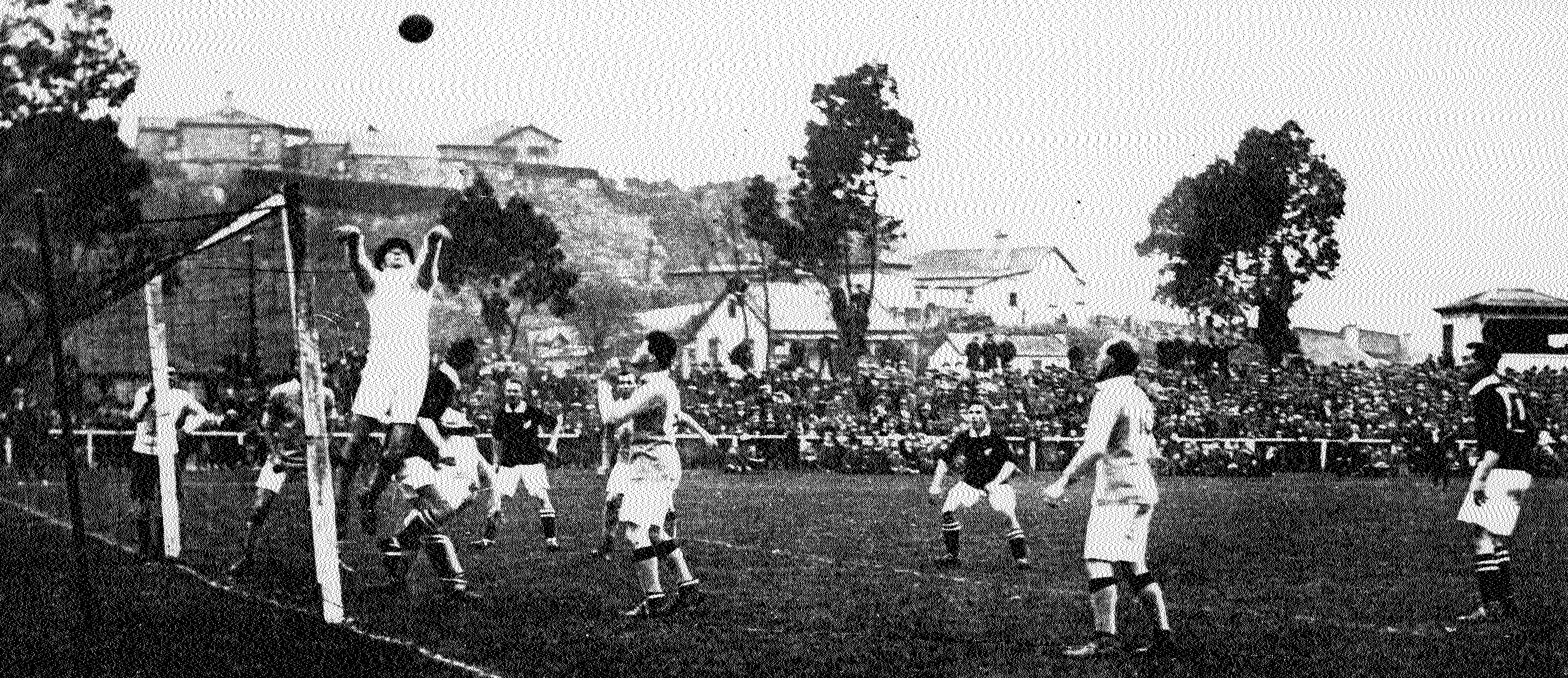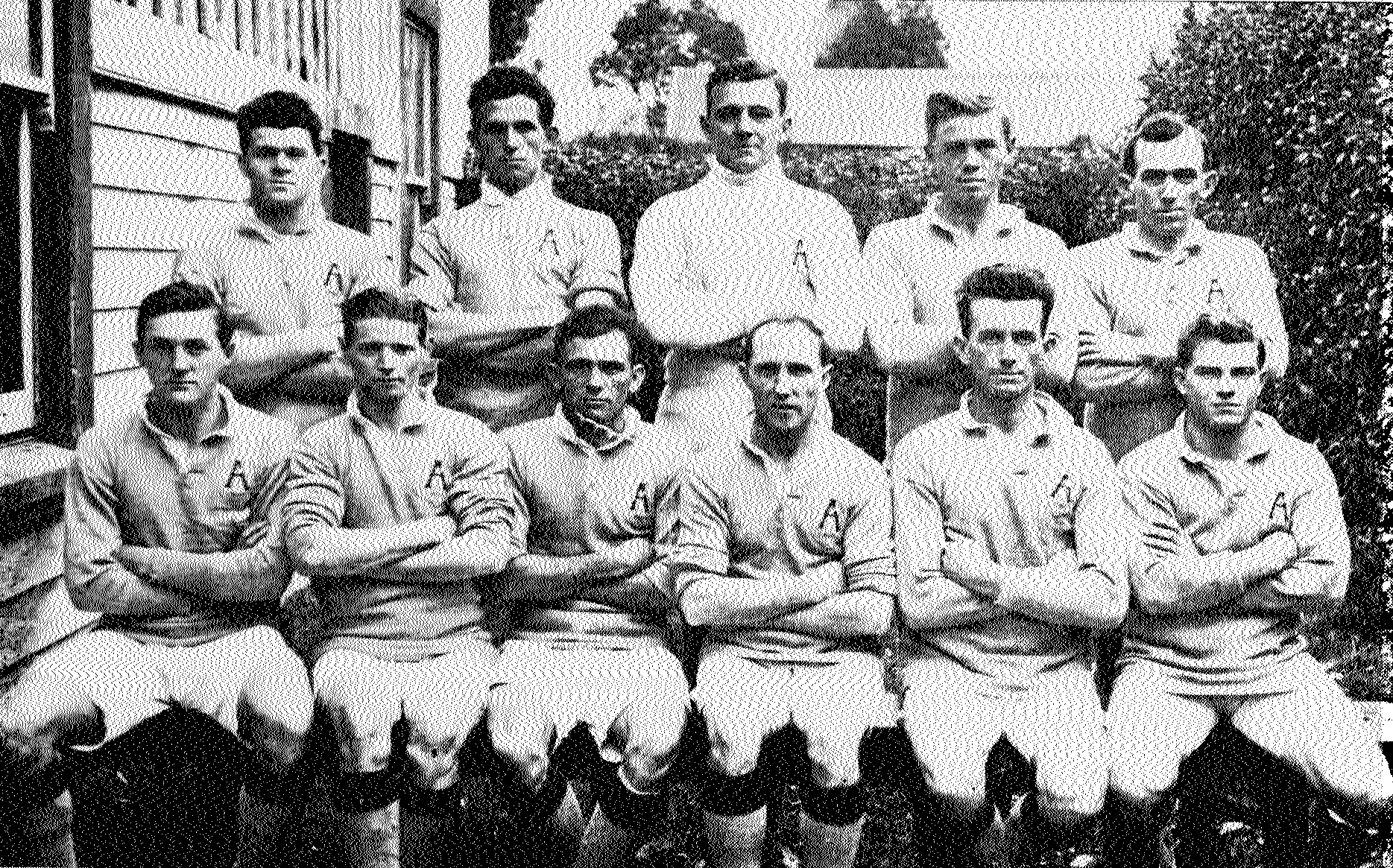International football comes to Nelson
When the History-making Australian football team played in Nelson Just weeks before New Zealand played Australia in its first ever football international 100 years ago, the visiting team had played in Nelson. Action from the first football international between New Zealand and Australia at Carisbrook in 1922.
When the History-making Australian football team played in Nelson
Just weeks before New Zealand played Australia in its first ever football international 100 years ago, the visiting team had played in Nelson.
Cook Strait was an uncharacteristic “sea of glass” when the Australian association football team crossed it on Tuesday May 30, 1922. The calm voyage from Wellington to Nelson on the steamer Kaitoa saw the 16 players and manager Alf Morgan sailing between two important moments in Australasian footballing history.
Three days earlier in Whanganui, the Australians had played their first ever match as a nation. And in Dunedin on June 17, they’d meet New Zealand in what was the first full international for both countries.
The centenary of that “first test” passed with little fanfare on this side of the Tasman last week. But in Australia the occasion has been celebrated with two books. As well as the Football Australia endorsed Socceroos: 100 Years of Camaraderie and Courage coffee table edition, there is Nick Guoth and Trevor Thompson’s Burning Ambition: The Centenary of Australia-New Zealand Football Ashes. A brilliantly researched telling of the birth of Antipodean international football, Burning Ambition covers the development of the game in both countries, and the story behind Australia’s 1922 tour and the return visit of New Zealand to Australia in 1923.
“Our book is about the development of football in both Australia and New Zealand, and the relationship between the two,” co-author Guoth says. “The ‘burning ambition’ was to get the English to come out.”
However, while football administrators on both sides of the Tasman were endeavoring to organise a visit from the English, they didn’t believe it was likely. And so in 1922 the New Zealand Football Association extended an invitation to the Commonwealth Football Association in Australia. This tour was to renew a connection that had first been forged when a New South Wales team visited New Zealand in 1904. But in 1922, the team consisted of eight New South Wales alongside eight from Queensland - due to those two states covering the cost of the tour.
The Australian strip was therefore not the green and gold now associated with Australian sides. Instead it was light blue, with maroon hoops on the socks and a maroon ‘A’ crest, incorporating the colours of New South Wales and Queensland. Guoth, who has written about Australian football history as both a journalist and academic, visited New Zealand in 2006 to research the 1922 tour. He visited the venues of the matches, as well as newspapers and libraries.
After beating Wanganui 3-1, Nelson was the second match on the Australian’s itinerary. After their morning arrival the day before the match, the team had a short practice at Trafalgar Park, and a visit to Nelson Boys’ College at the invitation of the principal. Next was an official welcome at the Civic Chambers, presided over by Mayor William Lock.
“The game commenced in Nelson last season, and it could hardly be expected that the local team could beat such a strong combination,” the Nelson Evening Mail reported. “But he felt sure that they would put up a good fight and do their best to win - and if beaten were sports enough to congratulate the winners.”
Allen Fisher had captained the visitors in Whanganui, although Alex Gibb would have that honour in Nelson and for the three international tests. “We are here to play the game to a man in every way,” Fisher said. “Of course we are out to win, but if your representatives beat us, we will be the first to congratulate them.”
That evening, both teams were entertained at the Masonic Hotel as guests of the newly formed Nelson Football Association, and a dance at the Oddfellows Hall. The weather for the 3pm game at Trafalgar Park on Wednesday, May 31, was dull but fine. The crowd of 2000 were certainly entertained, as the Australians won 8-2. Although the score was 4-2 early in the second half,thanks to two goals from Nelson forward Wheeler, hattricks from New South Wales’ Dave Ward and Queensland’s George Brown sealed the substantial win.
“The local men played well but were outclassed by the speed, combination, and headwork of the visitors, who gave a good exhibition of the game,” the Nelson Evening Mail reported. The Australians departed for Wellington that same evening. On the Saturday, they were beaten 3-0 at the Basin Reserve by a Wellington side that included four who’d play for New Zealand in the international matches - including captain George Campbell.
Having played in Greymouth and Christchurch, the visitors then beat Otago at Carisbrook on the Wednesday leading up to the first test. That drizzly Dunedin Saturday afternoon of June 17, 1922, saw well over 10,000 people descend on the now demolished venue for what was advertised as “the event of the season”. In their research Guoth and Thompson stumbled upon the fact that this first match between New Zealand and Australia was also the first ever football international where the teams wore numbers on their shirts.
After the match Australian manager Morgan congratulated the locals on the 3-1 win. But his deputy Sid Storey - also a player - took issue with a difference in the interpretation of the rules of football between the two countries. New Zealand practiced ‘blocking’ - the obstruction of players off the ball, which was allowed under Football Association rules at the time. The home captain Campbell responded, saying he couldn’t understand the Australians’ argument. “The game was no parlor one, but was one of skill and also of strength,” Campbell said.
The blocking issue remained throughout the 1922 and 1923 tours, with Storey and Campbell often needling each other at functions. New Zealand won both series. That aside, the tours helped forge international football in Australasia, and a fierce rivalry between the two countries. The centenary of the first game was marked by matches in the two countries in 2022, both of which were won by Australia, and a game in 2023 for a newly re-discovered Trans-tasman trophy.
First XI of other football matches played in Nelson:
- 1869: The year before Charles Munro brought the rules of rugby home, Nelson College beat Nelson Football Club 2-0 at Victory Square - “the first match of the kind ever played in Nelson”.
- 1923: Nelson Wanderers lost 1-8 to Wellington YMCA in the ‘Wellington final’ of the very first Chatham Cup competition. YMCA went on to lose the final against Dunedin’s Seacliff.
- 1924: Playing under the Republic of China flag, the Chinese Universities side toured extensively, beating Nelson 3-4 at Trafalgar Park.
- 1927: Canada played four internationals and 19 matches against provincial sides on their New Zealand tour, including a 5-0 win over Nelson.
- 1958: 36 years after their first visit, the Australians (including legendary captain Joe Marston) beat a Nelson Combined side 6-0 in front of 1500 people.
- 1965: On a lengthy exhibition tour of the country, English First Division sides Blackpool beat Sheffield United 2-1 at Trafalgar Park.
- 1977: With player/coach Kevin Fallon at the helm, Nelson United beat New Brighton 1-0 at Rutherford Park in the club’s first ever Rothmans National League home match.
- 1978: With Nelson United being defending Chatham Cup holders, the final was hosted at Trafalgar Park. Unfortunately the locals lost 0-1 to Manurewa.
- 2014: The Nelson Marlborough Falcons lost the national Youth League final 0-3 to Auckland City at Trafalgar Park. But the following season they won the league.
- 2018: In a Chatham Cup semi-final at Saxton Field, Nelson Suburbs were beaten 0-2 by eventual cup winners Birkenhead United.
- 2016: Tasman United’s first home match in the NZ Football Championship was a 1-3 loss against a Hawkes Bay United side featuring Paul Ifill.
2023
Story by: Gavin Bertram
Further Sources
Books
- Guoth, N. & Thompson, T. (2022) Burning ambition : the centenary of Australia-New Zealand football ashes. Balgowlah Heights, N.S.W. : Fairplay Press
https://tepuna.on.worldcat.org/oclc/1333999489

